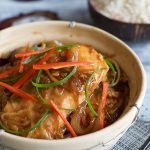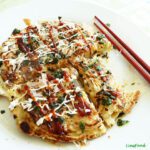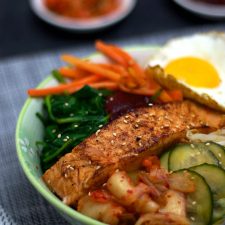This salmon bibimbap is an incredibly delicious bowl of contrasting flavours and textures – earthy, tangy, sweet and spicy.
Estimated reading time: 9 minutes
Table of contents

What does Bibimbap mean?
- bibim = mixed
- bap = cooked rice
- Bibimbap = mixed rice
Bibimbap is probably one of the more well known Korean recipes outside of Korea, along with Pajeon and Bulgogi. As you can see in the images here, it is a one bowl dish made up of rice and an assortment of side dishes, served with that ubiquitous of Korean red chilli pastes, gochujang (I’ll do a post on that soon).
In Korean homes, bibimbap is quite often made as a way of using up leftover dishes, so it’s a perfect fridge cleaner! That’s probably why it’s so popular in our house for weekday lunch! Well, popularly with me, because I always refrigerate bowls of food so I don’t have to cook too many times a day!
Bibimbap Recipe
A Bibimbap recipe is in fact a collection of a few recipes. As mentioned above, it is a bowl of rice topped with various side dishes, which are called banchan, in Korean.
So really, you could serve it with anything you have at hand or fancy. But there are some, that to me, are non negotiable, I must have them in my bowl.

Bibimbap Side Dishes (Banchan)
The side vegetables in bibimbap are just lightly blanched/sautéed and flavoured. Each component of bibimbap contributes flavour, aroma and texture to the final dish, and play a part in its own right.
I do like to keep the vegetables lightly flavoured though, as the protein, whether it’s beef, or the salmon today, is usually highly seasoned.
Any of the vegetables listed below will work, the ones I must have, have an asterisk next to them. Naturally, the beef isn’t present today, as I’m making Salmon Bibimbap.
- Beef* – traditionally, this would just be seasoned raw beef
- Beansprouts
- Spinach*
- Marinated (Quick Pickled) Cucumbers*
- Fried egg* – also traditionally raw
- Carrots
- Courgettes (zuchini)
- Mushrooms
- Fernbrake (gosari in Korean)
- Tofu
- Green beans, and so on
- kimchi*
Having grownup in South East Asia, I can tell you that this practice of serving rice with an assortment of side dishes is found all over the region, from Nasi Campur (which means mixed rice in Malay/Indonesian), Nasi Kandar to Nasi Lemak, below. When you are eating at stalls in Asia, you’d start with rice. Then, you’d ask for various side dishes to be heaped upon your plate.

Bibimbap Rice
Koreans tend to use short grain rice for their bibimbap. The sticky nature of the rice is perfect for absorbing all the wonderful flavours going on in the bowl.
My pantry (both home and business) is full of different types of rice for all the different rice dishes we cook. I grew up eating rice every day, more often than not, twice a day. The noodles were usually for breakfast or a snack. In fact, sometimes, breakfast would be rice too, in the form of Nasi Lemak; that would make it 3 times a day!
Yeah, I’m a rice monster!
These days, living in England, we still cook rice every day, there’s always one pesky child who insists on rice. And I’m not really a potato person. I like it, but not as much as I like my rice!
So these are just some of the rice types we have in the pantry:
- basmati rice
- jasmine rice
- Thai sticky rice
- risotto (carnaroli, arborio, vialone nano)
- paella rice
- sushi rice
So what rice do I use to make Bibimbap?
I find sushi rice is the best for bibimbap. Thai sticky rice is way too sticky, and jasmine rice, not sticky enough, although its perfume is fantastic.

Bibimbap Sauce
Some people are happy serving bibimbap with just plain gochujang sauce, but I love lightening and heightening gochujang with some sesame oil and vinegar, and sometimes a hint of garlic. It really is the easiest thing.

Bibimbap Bowl/Dolsot Bibimbap
Bibimbap is often made in a stone bowl called dolsot. These stone bowls are greased with sesame oil, filled with all the bibimbap ingredients, then placed on the hob and the rice right at the bottom is allowed to crisp up before being served. Almost like the Persian tahdig! Totally awesome, and yet another piece of the delicious bibimbap jigsaw!
To turn our Salmon Bibimbap into a Dolsot Bibimbap, just use a stone bowl claypot and heat it, as described above, for just 2 minutes, on medium heat. You’ll hear the rice crackling away.
I’ll do a recipe with beef soon using a stone pot. Here in the UK, you can get them online, but they are fairly expensive, especially after postage and packaging.
How to eat Bibimbap?
With a spoon, chopsticks optional, and mix it all up! Then dig in, adding more gochujang sauce as you go along. Or in my case, more kimchi too! Yes, I love the stuff!
I can’t believe I don’t have a kimchi recipe on my blog. I make it regularly for myself and for clients. Just this past weekend, someone begged me to make them a quick kimchi.
Watch this space!

Salmon Bibimbap Recipe
- salmon is my favourite fish and here, it commands attention with every mouthful
- the spinach lends a grassy earthiness
- the carrots impart a touch of sweet
- the beansprouts give a slightly squeaky, light feel to the dish, even if I have added some soy sauce to them
- the marinated cucumbers add a salty, tangy flavour
- the kimchi, again, lends a tangy and slightly spicy dimension, besides being good for you
- the egg – well, who doesn’t love fried eggs?
⇒ I’ve also used toasted sesame oil, light soy sauce and garlic here and there with the salmon and vegetables, as you’ll see in the recipe. All this further enhances the overall flavour, with the sesame oil especially being a wonderful nutty, toasty addition.
Our Salmon Bibimbap recipe can all be done in 45 minutes flat. In fact, it takes me about 30 minutes, as I cook the eggs while I’m cooking the salmon. Yes, 2 frying pans, it’s only another pan!
Let’s face it, with 4 homeschooling kids, there’s always stuff to wash up!
This is how we cook our Salmon Bibimbap:
- marinate the salmon
- slice the cucumbers and marinate them
- cook the rice
- while the rice is cooking, make the gochujang sauce (and everything else below)
- slice and cook the carrots
- cook the spinach
- cook the beansprouts
- cook the salmon
- fry the eggs
- dish up
Vegetarian or Vegan Bibimbap
It’s very easy to cook up a vegetarian bibimbap or a vegan bibimbap. The dish is just begging to be made so! Replace the salmon with tofu, lose the egg, and you have a clear winner! Tempeh would also be a good protein in this.
Salmon Bibimbap Recipe in Pictures
Then, let’s get bibimbaping cooking!






More East & South East Asian Recipes



Images by LinsFoodies


If you like the recipe, don’t forget to leave me a comment and that all important, 5-star rating! Thank you!
And if you make the recipe, share it on any platform and tag me @azlinbloor.
Lin xx

Salmon Bibimbap (a Korean Rice Bowl Recipe with Kimchi)
Ingredients
The ingredients are listed in the order that we shall be preparing them.
Salmon
- 4 salmon fillets
- 1 Tbsp light soy sauce
- ½ tsp sesame oil
- freshly ground black pepper
- 1 tsp gochujang optional, if you don’t like spicy
Cucumbers
- 1 large cucumber
- 1 Tbsp light soy sauce
- ½ tsp sesame oil
- 1 tsp rice vinegar or any clear vinegar
Rice
- 500 g (2½) cups sushi rice
- 700 ml (2 4/5) cups water (or as on the packet instructions)
- 1 tsp salt
Gochujang Sauce
- 170 g (½ cup) gochujang
- 1 Tbsp sesame oil
- 4 Tbsp water
- ½ tsp white sugar
- 1 tsp rice vinegar or any clear vinegar
Carrots
- 1 large carrot
- ½ tsp oil
- pinch of salt
Spinach
- 200 g (7 oz) fresh baby spinach
- 1 clove garlic
- pinch of salt
Beansprouts
- 200 g (7 oz) beansprouts
- 1 tsp light soy sauce
- dash of ground white pepper or black if you don’t have white
The Rest
- 2 Tbsp vegetable oil 1 for salmon, if needed, 1 for eggs
- 4 eggs
To Serve
- lots of kimchi
- 2 tsp sesame oil
- gochujang sauce
- 2 spring onions scallions, sliced, optional
- sprinkling of sesame seeds optional
Instructions
Salmon
- Mix all the ingredients together and marinate the salmon. Set aside.
Cucumbers
- Thinly slice the cucumbers and place in a bowl. Pour the soy sauce, sesame oil and vinegar over, toss and leave to marinate.
Rice
- Rinse the rice twice.
- Add the water and salt, and bring to a boil. Leave to cook, uncovered, until the water has evaporated.
- Lower heat right down, cover and simmer for 10 minutes. At the end of 10 minutes, turn the heat off, take off the hot hob and leave to rest for 10 minutes before fluffing up and serving.
Gochuijang Sauce
- Mix all the ingredients together, and set aside.
Carrots
- Julienne the carrot (cut into matchsticks).
- Heat the oil in a large, non stick pan on medium heat and fry the carrots for 2 minutes to soften, adding the salt. I like to have the heat slightly high to le the edges of the carrots brown slightly, for a sweet, caramelised flavour.Tip onto a plate and keep warm.
Spinach
- Slice the garlic widthwise.
- In the same pan, tip in all the spinach, the garlic and salt. I don’t bother with oil. Heat on medium heat, cover, and leave the spinach to wilt for about 2 minutes, stirring once or twice.
- Tip onto a plate and keep warm.
Beansprouts
- Same pan, same medium heat, fry the beansprouts for 2 minutes, adding the soy sauce and pepper. Tip onto a plate and keep warm.
Let’s cook the salmon
- Give the pan a wipe with a kitchen paper, and heat on medium heat. Add a tablespoon of vegetable oil if you need to, and cook the salmon fillets starting with the skin side down. Tip in the marinade and let it bubble away.
- After 2 minutes, turn the fillets around and cook for another 2 minutes.
- Finally, turn them back onto their skin and cook for a final 1 minute. This will crisp up the skin. When the salmon is cooked, tip onto a plate and keep warm, and let’s do the eggs.
Eggs
- Wipe the pan clean, tip in 1 Tbsp vegetable oil and fry the eggs, sunny side up until just set and the yolk is still runny. Take off the heat. You can, if you want to, tip them onto a plate to keep them from cooking further. I leave them in the pan.
To Serve
- Half fill 4 bowls with the sushi rice.Top with everything that we’ve prepared and the kimchi. So: salmon, carrots, spinach, beansprouts, cucumber, kimchi, egg, gochujang sauce.
- I like to drizzle the cucumber marinade over the cucumbers on the rice. Drizzle some sesame oil all over, if you like.
- Top with the spring onions (scallions) if using.
- Have extra bowls of the gochujang sauce and kimchi for everyone to help themselves to.
Notes
** Total time and prep time reflects that the prep and cooking of the banchan is done while the rice is cooking.

I have never had this dish before. But it certainly looks amazing. I would love to take a taste.
My goodness, this looks delicious! I had kimchi for the first time last year and loved it, so I am sure this dish is tasty and it sounds healthy!
Oh my goodness this all looks so good!
Looks so delicious and healthy! Fish, veggies and rice all in one bowl! I have to try making this at home. I am sure it will be another family favorite. Thank you for the recipe!
I haven’t tried Korean food yet but after reading this, i really want to try this. I think i will take baby step and try it first before attempting the recipe.
I enjoy eating Bibimbap but I have never tried making it myself. Thanks for the recipe. I will get the ingredients together and give this a shot. Yum!
Looks yummy! Jam pack filled with veggies (alot of my favs) easy instructions and decent cook time
Wow… This looks so delicious. I must try this sometime. Thanks for sharing this recipe.
Great quality photos thanks. loving the detail you give on the recipe too
Thanks, this is an awesome recipe! A New Year and a new cuisine for me. Gonna make this at the weekend.